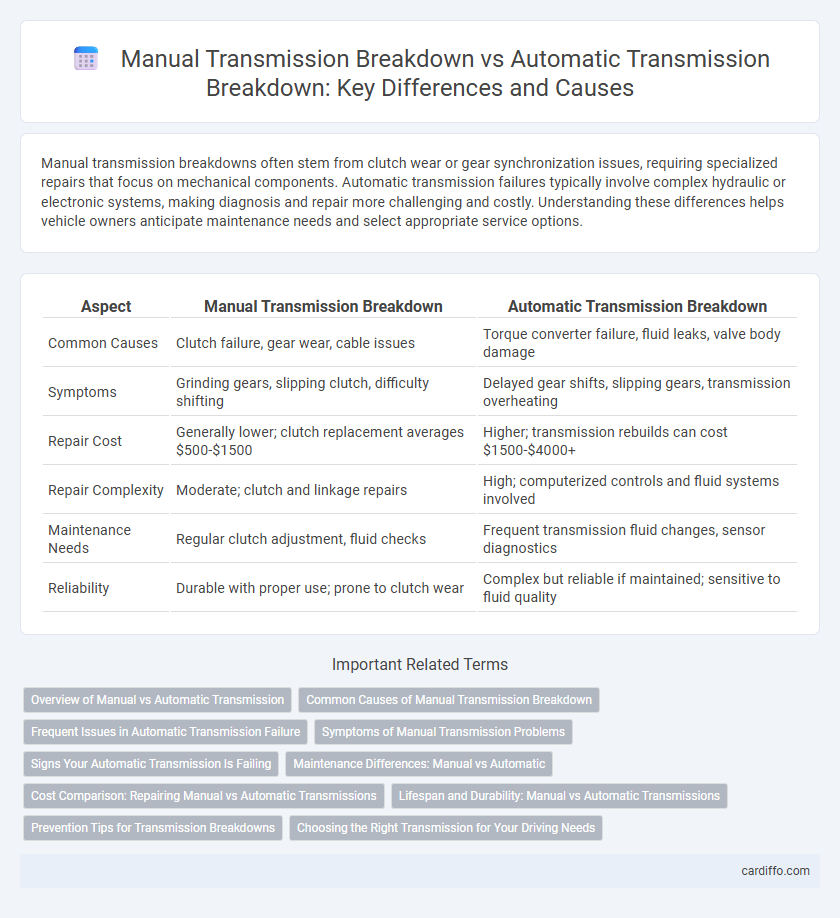Manual transmission breakdowns often stem from clutch wear or gear synchronization issues, requiring specialized repairs that focus on mechanical components. Automatic transmission failures typically involve complex hydraulic or electronic systems, making diagnosis and repair more challenging and costly. Understanding these differences helps vehicle owners anticipate maintenance needs and select appropriate service options.
Table of Comparison
| Aspect | Manual Transmission Breakdown | Automatic Transmission Breakdown |
|---|---|---|
| Common Causes | Clutch failure, gear wear, cable issues | Torque converter failure, fluid leaks, valve body damage |
| Symptoms | Grinding gears, slipping clutch, difficulty shifting | Delayed gear shifts, slipping gears, transmission overheating |
| Repair Cost | Generally lower; clutch replacement averages $500-$1500 | Higher; transmission rebuilds can cost $1500-$4000+ |
| Repair Complexity | Moderate; clutch and linkage repairs | High; computerized controls and fluid systems involved |
| Maintenance Needs | Regular clutch adjustment, fluid checks | Frequent transmission fluid changes, sensor diagnostics |
| Reliability | Durable with proper use; prone to clutch wear | Complex but reliable if maintained; sensitive to fluid quality |
Overview of Manual vs Automatic Transmission
Manual transmission breakdowns often involve clutch wear, gear synchronization issues, and linkage problems, which can lead to difficulty shifting or complete transmission failure. Automatic transmission breakdowns typically stem from fluid leaks, torque converter malfunctions, or electronic control failures, causing slipping gears or delayed shifting. Understanding these distinct failure modes is essential for targeted maintenance and repair strategies.
Common Causes of Manual Transmission Breakdown
Manual transmission breakdowns often occur due to clutch wear, improper shifting, and low transmission fluid levels. Worn-out clutch plates cause slipping and difficulty engaging gears, while incorrect gear changes lead to gear grinding and synchro damage. Lack of lubrication accelerates component wear, resulting in costly repairs and potential transmission failure.
Frequent Issues in Automatic Transmission Failure
Automatic transmission breakdowns commonly result from fluid leaks, overheating, and worn clutch components, which impair smooth shifting and drivetrain performance. Torque converter problems and sensor malfunctions also frequently cause erratic gear changes or complete transmission failure. Compared to manual transmissions, automatic systems feature more complex hydraulics and electronics, increasing susceptibility to frequent issues requiring specialized diagnostics and repairs.
Symptoms of Manual Transmission Problems
Symptoms of manual transmission problems include difficulty shifting gears, grinding noises during gear changes, and a burning smell indicating clutch issues. Drivers may experience a slipping clutch, where the engine revs increase without a corresponding increase in vehicle speed. Leaking transmission fluid and a soft or spongy clutch pedal are also common signs of manual transmission breakdown.
Signs Your Automatic Transmission Is Failing
Grinding noises, delayed or harsh shifting, and slipping gears are common signs your automatic transmission is failing, often indicating worn clutch components or low transmission fluid. Warning lights on the dashboard, such as the check engine light or transmission temperature warning, signal potential internal damage requiring immediate diagnostic attention. Frequent overheating and burning smells also suggest critical transmission issues that can lead to complete breakdown if left unresolved.
Maintenance Differences: Manual vs Automatic
Manual transmission breakdowns often result from clutch wear or improper shifting, requiring regular clutch inspections and fluid changes to prevent costly repairs. Automatic transmissions demand consistent transmission fluid checks and timely replacements to avoid overheating and gear slipping. Differentiating maintenance schedules is crucial, as manual systems emphasize mechanical component care while automatic systems rely heavily on hydraulic and electronic fluid management.
Cost Comparison: Repairing Manual vs Automatic Transmissions
Repairing a manual transmission typically costs between $1,000 and $3,000, depending on the extent of the damage and labor rates, while automatic transmission repairs can range from $1,800 to $4,000 or more due to complex components like torque converters and electronic controls. Manual transmissions generally have fewer parts prone to failure, resulting in lower maintenance and repair expenses compared to the higher cost of diagnosing and fixing automatic transmission issues. Insurance companies and repair shops often factor in longer labor times and specialized equipment when estimating automatic transmission repair costs.
Lifespan and Durability: Manual vs Automatic Transmissions
Manual transmissions often exhibit greater lifespan and durability compared to automatic transmissions due to their simpler mechanical design and fewer electronic components. The clutch and gearbox in manual systems can last 100,000 to 150,000 miles with proper maintenance, whereas automatic transmissions, which rely on complex hydraulic systems and electronics, typically face issues after 100,000 miles. Regular fluid changes and careful driving habits are crucial for extending the durability of both transmission types, but manuals generally endure more wear and tear before requiring major repairs.
Prevention Tips for Transmission Breakdowns
Regularly checking and maintaining the transmission fluid level and quality is crucial to prevent breakdowns in both manual and automatic transmissions. For manual transmissions, ensuring proper clutch adjustment and avoiding riding the clutch pedal can significantly extend transmission life. In automatic transmissions, timely servicing of the transmission filter and avoiding aggressive driving helps prevent overheating and internal damage.
Choosing the Right Transmission for Your Driving Needs
Manual transmission breakdowns often result from clutch wear, gear synchronization issues, or hydraulic failures, requiring specialized repairs. Automatic transmissions tend to face problems like torque converter malfunctions, valve body failures, or transmission fluid leaks, which can be more complex and costly to fix. Assessing your driving habits, maintenance willingness, and repair costs helps determine whether a manual or automatic transmission aligns best with your long-term vehicle reliability and performance needs.
manual transmission breakdown vs automatic transmission breakdown Infographic

 cardiffo.com
cardiffo.com